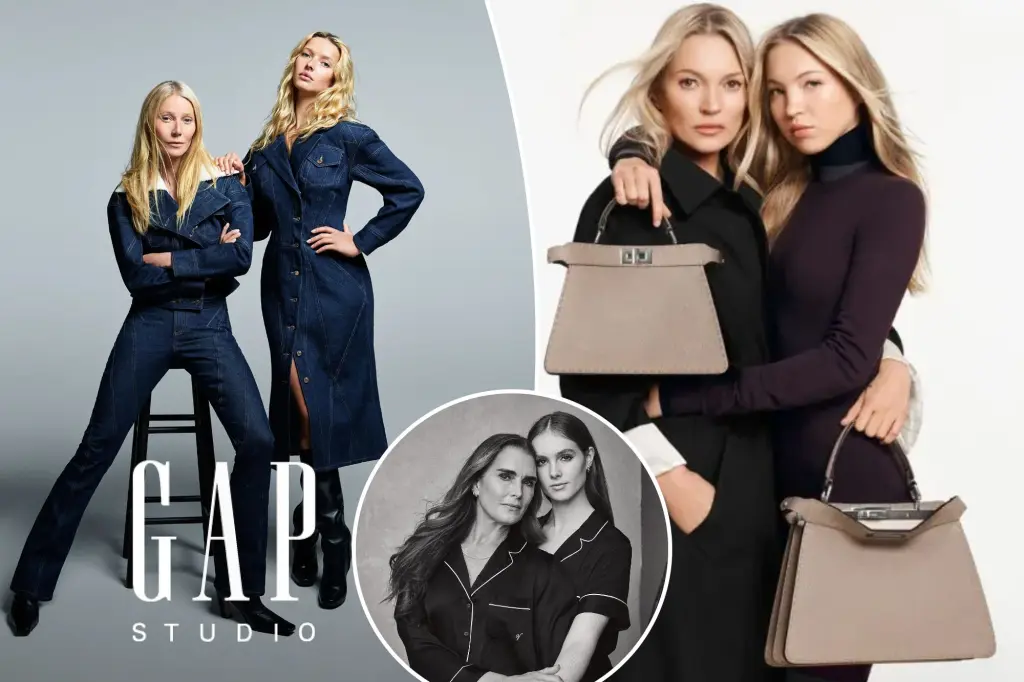The Evolution of Celebrity Mother-Daughter Collaborations in Advertising
In the world of high fashion and luxury brands, a new trend is taking center stage: celebrity mothers and their daughters appearing together in advertising campaigns. This phenomenon, often referred to as “nepo-baby” collaborations (a nod to nepotism), has become increasingly prevalent as brands seek to capture multi-generational appeal. The latest to join this exclusive club is Gwyneth Paltrow, who recently posed alongside her 21-year-old daughter Apple Martin for GapStudio’s Fall 2025 campaign. The pair, looking strikingly similar in matching denim outfits, represent the brand’s effort to “bridge generations” through fashion. For Apple, this opportunity follows her recent appointment as an ambassador for London fashion house Self-Portrait, suggesting her career in the spotlight is just beginning to blossom.
The Paltrow-Martin collaboration is far from an isolated case. Across the fashion and luxury landscape, prominent mother-daughter duos are becoming the faces of major brands. Perhaps one of the most talked-about partnerships was between supermodel Heidi Klum and her daughter Leni, who appeared together in lingerie campaigns for Italian brand Intimissimi in 2023 and again in 2024. The provocative nature of these advertisements, featuring the mother and daughter in lacy undergarments, sparked considerable online controversy, with critics describing the concept as “weird” and “insanely odd.” Despite the backlash, the Klums have continued their collaborative work, suggesting that the attention—whether positive or negative—serves both the brand and the emerging career of the younger Klum.
Other notable mother-daughter partnerships have included ’90s supermodel Kate Moss and her daughter Lila, who modeled together for Fendi’s Peekaboo handbag line, showcasing an uncanny resemblance that spans generations. Music royalty has also embraced this trend, with Beyoncé featuring her daughter Blue Ivy Carter in a 2021 Tiffany & Co. advertisement alongside father Jay-Z. Blue Ivy’s presence in the public eye has since expanded beyond static advertisements; she joined her mother on stage during both the Renaissance World Tour in 2024 and the Cowboy Carter tour in 2025, demonstrating that these collaborations can serve as launching pads for young performers seeking to establish themselves in entertainment. These partnerships often blur the line between professional opportunity and family bonding experience, creating narratives that resonate with consumers on an emotional level.
The fashion world has seen numerous other powerful mother-daughter pairings in recent years. Actress Andie MacDowell and her musician daughter Rainey Qualley collaborated for Coach’s Mother’s Day campaign in 2021, celebrating their shared love of fashion. MacDowell, who is also mother to actress Margaret Qualley, told Vogue that fashion has always been something the women in her family have enjoyed together, highlighting how these professional opportunities often align with authentic family dynamics. Similarly, supermodel Cindy Crawford and her daughter Kaia Gerber posed together for luxury watch brand Omega in 2018, with the campaign aptly captioned “Two generations. One choice.” The visual impact of these pairings—particularly when the resemblance is as striking as in the Crawford-Gerber case—creates powerful marketing imagery that emphasizes legacy and timelessness, qualities that luxury brands are eager to associate with their products.
In an interesting twist on the traditional mother-daughter dynamic, some campaigns feature established celebrities alongside their own mothers, rather than their children. Supermodel Naomi Campbell, known for her unparalleled runway presence, appeared with her mother Valerie Morris-Campbell in a 2018 Burberry campaign, demonstrating that the appeal of family resemblance and generational continuity works in both directions. This approach allows brands to showcase the origins of beauty and style that consumers have admired for decades, while simultaneously humanizing iconic figures by placing them in relatable family contexts. These campaigns tap into universal themes of maternal bonds and inherited traits, making luxury products feel more accessible through emotional connection.
The emotional power of these mother-daughter partnerships was perhaps most explicitly demonstrated in a 2022 Victoria’s Secret campaign featuring actress Brooke Shields and her daughter Grier Henchy. During the shoot, which showcased the pair in matching pajamas, Shields became visibly emotional, expressing that she “didn’t bargain to feel the pain of loving this much.” This raw moment captures the duality of these collaborations—they are simultaneously professional opportunities and deeply personal experiences. For the mothers, these campaigns often represent a passing of the torch, a chance to introduce their daughters to industries they’ve navigated for decades. For the daughters, they offer entrée into exclusive worlds and the opportunity to establish their own identities while benefiting from their mothers’ experience and connections. For brands, these partnerships provide compelling visual stories of continuity, legacy, and evolution—powerful selling points in an increasingly competitive marketplace.
As these mother-daughter collaborations continue to proliferate in advertising, they raise interesting questions about opportunity, privilege, and authenticity in the modern media landscape. While critics may point to the “nepo-baby” phenomenon as evidence of unfair advantage, these partnerships also reflect genuine familial bonds and shared interests. Brands recognize the marketing power of genetic resemblance, emotional connection, and the visual impact of seeing beloved celebrities alongside their progeny. Whether viewed as clever marketing strategy or the natural evolution of celebrity culture, these campaigns effectively bridge generational divides, appealing to longtime fans of established stars while introducing new audiences to emerging talents. As Apple Martin, Leni Klum, and their contemporaries continue to develop their own public personas, the influence of these early collaborative appearances—and the doors they’ve opened—will likely shape their careers for years to come.


